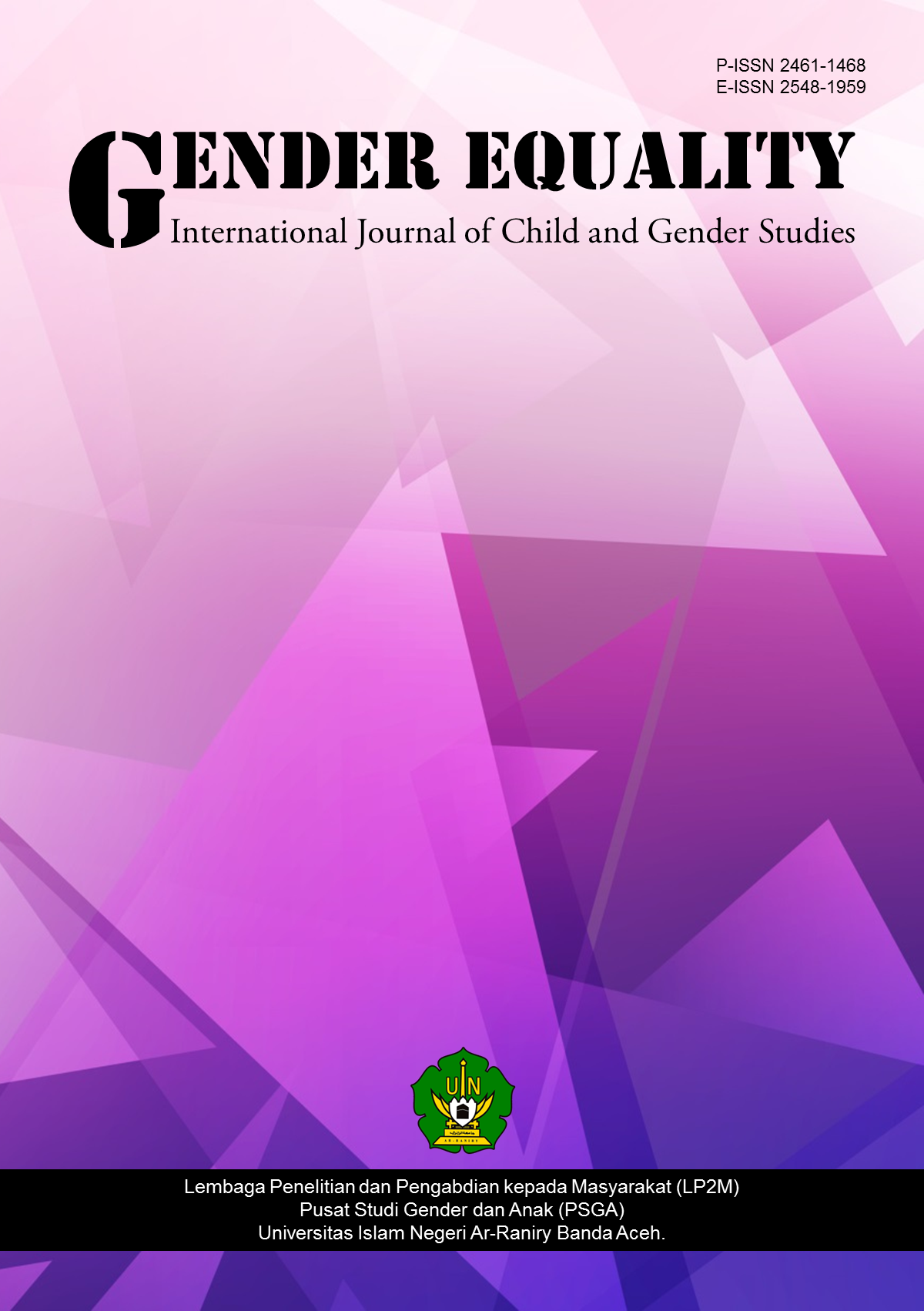MOTHER'S VIOLENT BEHAVIOR IN CHILDREN
DOI:
https://doi.org/10.22373/equality.v6i2.7648Keywords:
mother's, violent, behavior, poor peopleAbstract
This study aims to get a picture of the forms of violent behavior perpetrated by mothers against children in poor communities. The research respondents classified as poor were obtained by the category of families who received the Program Keluarga Harapan (PKH) assistance, totaling 140 people. Measuring instruments using a scale of violence against children are arranged based on forms of violence against children. Based on demographic data, the following description of respondents was obtained: 93% were married, 96% were housewives, 52% were elementary school graduates, 66% were husband's work as laborers. While the results of the analysis of items on the scale of violence against children obtained data that the form of violent behavior of mothers against children includes: hitting children with hands or with light objects, pinching, slapping, threatening not to give money, calling children by nicknames, comparing children with other children, and say deaf to children. This form of violence is perpetrated by mothers against children with a frequency of 17% rarely, 69% sometimes and 14% often.
References
Al-Faruq, A. (2011). Ibu Galak Kasihan Anak. Solo: Kiswah Media.
Azwar, S. (2012). Metode Penelitian. Yogyakarta: Pustaka Pelajar.
Azwar, S. (2013). PenyusunanSkala Psikologi.Yogyakarta: PustakaPelajar.
Burtchart, A., & Harvey, A.P. (2006).Preventing Child Maltreatment: A Guide To Talking Action And Generation Evidence.Switzerland: WHO Press.
Diana, J. E. (1998). The Extent and Consequences of Child Maltreatent. Journal Protecting Children from Abuse and Neglect. 8, (2). 39 52.
Fitriana, dkk. (2015). Faktor-Faktor Yang Berhubungan Dengan Perilaku Orang Tua dalam Melakukan Kekerasan Verbal Terhadap Anak Usia Pra Sekolah. Jurnal Psikologi Undip.Vol.14 No.1. 81-93.
Gelles, R.J. & Straus M. (1989). The Marriage License As A Hitting License: A Comparison Of Assault In Dating, Cohabiting, And Married Couples. American Journal of Family Violence. 41 (2).
Gelles, R.J. (1980). Violence In The Family. Journal of Marriage and Family. Vol.42, No.4. 873-885.
Gelles, R.J. (1990). Reconceptualizing Child Abuse. American Journal Orthopsychiatry. 43:611-21.
Hanurawan, F. (2010). Psikologi Sosial. Bandung. PT Remaja Rosdakarya.
Huda, N. (2008). Kekerasan Terhadap Anak dan Masalah Sosial Yang Kronis. Pena Justisia. Vol. VII. No.14.
Huraerah, A. (2006). Child Abuse (kekerasan terhadap anak) edisi revisi. Bandung: Nuansa.
Huraerah, A. (2012). Child Abuse (kekerasan terhadap anak) edisi revisi. Bandung: Nuansa.
Hurlock, E.B. (1980). Psikologi Perkembangan (Suatu Pendekatan Sepanjang Rentang Kehidupan). Jakarta: Erlangga.
Ikawati, A. (2013). Kekerasan Ibu Single Parents Terhadap Anak. Artikel. Psikologi/Fisip Universitas Brawijaya Malang, Jawa Timur.
Khusmas, A., Hastarjo, T.D., Wimbarti, S. (1997). Peran Fantasi agresif tentang perilaku agresif anak-anak. Jurnal Psikologi. No 1 , 21 29.
Krahe, B. (2005). Perilaku Agresif. Yogyakarta: Pustaka Pelajar
Langer, A., & Laerence, E. (2009). Emotion Regulation And Experiental Avoidance In Intimate Partner Violence. Advences In Sociology Research, Vol.6. 1-29.
Lestari, S. (2012). Psikologi Keluarga: Penanaman Nilai dan Penanganan Konflik dalam Keluarga. Jakarta: Kencana Prenada media group.
Margaretha,. Nuringtyas, R., & Rachim, R. (2013). Trauma Kekerasan Masa Kanak dan Kekerasan dalam Relasi Intim. Makna Seri Sosial Humaniora, 17 (1): 33-42.
Myers, D.G. (2012). Psikologi Sosial (Edisi 10. Buku 2). Jakarta: Salemba Humanika.
Newberger E, Newberger M & Hampton. (1983). Child Abuse: Journal of the American Academy of Child Psychiatry, 22, 3:262 268.
Newberger M & Newbeger E. (1982). Prevention of Child Abuse: Theory, Myth, Practice. Journal Of Preventive Psychiatry. Vol 1,No. 4.
Nugrahani, S. (2015). Hubungan Parenting Stress Dengan Kecendrungan Prilaku Kekerasan Terhadap Anak. Skripsi. Fakultas Ilmu Pendidikan Universitas Negeri Semarang.
Santrock, J. W. (2007).Perkembangan Anak. Jilid II.Jakarta: Erlangga.
Sears, D.O., Freedman, L., & Peplau, A. (2005). Psikologi Sosial(Jilid 2) Edisike 5. Alih bahasa oleh Michael Adryanto. Jakarta: Erlangga
Soeroso, M. H. (2011). Kekerasan Dalam Rumah Tangga. Jakarta: Sinar Grafika.
Straus M.A. (1994). Beating th eDevil Out of Them: Corporal Punishment in American Families. Review Books.
Straus, M.A & Donnelly, M. (2005). Corporal Punishment of Children in Theoretical Perspective. Cambridge University Press: America.
Straus, M.A., & Gelles, R.J. (1988). Violence in American Families: How Much Is There And Why Does It Occur. Famlies In Trouble Series Publication. Vol.3.
Straus, M.A., & Hamby, S.L. (1995). Parent-Child Conflict Tactics Scales, Form A. Chicago: American Educational Research Assosiation.
Straus, M.A., Hamby, S.L., Boney McCoy, S., Sugarman, D.B., Finkelhor, D., Moore, D.W., & Runyan, D.K. (1998). Conflict Tactics Scale (CTS).
Straus, M.A., Hamby, S.L., Finkelhor(1997).Indentification of Child Maltreatment with the Parent Child Conflict Tactics Scale. Chicago: American Educational Research Assosiation.
Sugiyono. (2013). Statiska untuk Penelitian. Bandung: Alfabeta.
Taylor, E.S., Peplau, L.A, Sears, D.O. (2009). Psikologi Sosial. Jakarta: Salemba
World Health Organization. (2002). World Report on Violence and Health. Switzerland: Genev.
Downloads
Published
Issue
Section
License
GENDER EQUALITY: International Journal of Child and Gender Studies allows the author(s) to hold the copyright and to retain the publishing rights without restrictions. Authors who publish with this journal agree to the following terms:
- Authors retain copyright and grant the journal right of first publication with the work simultaneously licensed under a Creative Commons Attribution License that allows others to share the work with an acknowledgment of the work's authorship and initial publication in this journal.
- Authors are able to enter into separate, additional contractual arrangements for the non-exclusive distribution of the journal's published version of the work (e.g., post it to an institutional repository or publish it in a book), with an acknowledgment of its initial publication in this journal.
- Authors are permitted and encouraged to post their work online (e.g., in institutional repositories or on their website) prior to and during the submission process, as it can lead to productive exchanges, as well as earlier and greater citation of published work.



